Lab Experiments for Abrasive Waterjet Perforation and Fracturing in Offshore Unconsolidated Sandstones
Abstract
:1. Introduction
2. Abrasive Waterjet Perforation in Gravel Pack Completion
2.1. Capacity of Abrasive Waterjet Penetrating Screen Liner and Casing
2.2. Capacity of Waterjet Perforation in Unconsolidated Sandstone
3. Optimization of Bottom-Hole Tool and Procedures of Offshore Hydra-Jet Fracturing
3.1. Optimization of Key Parameters of Waterjet Nozzles
3.2. Design of Bottom-Hole Tool String for Offshore Hydra-Jet Fracturing
3.3. Hydra-Jet Fracturing Process
4. Case Study
4.1. Reservoir Characteristics
4.2. Pump Pressure Checking
4.3. Operation and Requirements
5. Conclusions
- (1)
- The abrasive water jet is capable of perforating the screen-casing in less than one minute with an over 10 mm diameter hole. The water jet perforates a deep and slim hole in unconsolidated sandstone by using less than 20 MPa pumping pressure. Recommended perforating parameters include: maintain 7% sand ratio and perforate for 3.0 min, reduce sand ratio to 5%, maintain 3.0 m3/min flow rate, and continue perforating for 7.0 min.
- (2)
- Nozzle pressure drop accounts for more than 62% of the tubing pump pressure. Optimizing the nozzle combination can significantly reduce the pump pressure. The recommended nozzle combinations for different fracturing flow rates are 8 × 6 mm or 6 × 7 mm for 2.5 m3/min and 3.0 m3/min, and 8 × 7 mm for 3.5 m3/min and 4.0 m3/min.
- (3)
- To avoid the sand sticking issue, a one-trip-multistage jet fracturing process is recommended for use in horizontal wells in offshore unconsolidated sandstone reservoirs.
Author Contributions
Funding
Data Availability Statement
Conflicts of Interest
References
- Yan, C.; Chen, Y.; Chen, T.; Cheng, Y.; Yan, X. Experimental Study of Hydraulic Fracturing for Unconsolidated Reservoirs. Rock Mech. Rock Eng. 2022, 55, 3399–3424. [Google Scholar] [CrossRef]
- Monus, F.L.; Broussard, F.W.; Ayoub, J.A.; Norman, W.D. Fracturing unconsolidated sand formations offshore Gulf of Mexico. In Proceedings of the SPE Annual Technical Conference and Exhibition, Washington, DC, USA, 4–7 October 1992. [Google Scholar]
- Molenaar, M.M.; Cox, B.E. Field cases of hydraulic fracture stimulation diagnostics using fiber optic distributed acoustic sensing (DAS) measurements and Analyses. In Proceedings of the SPE Unconventional Gas Conference and Exhibition, Muscat, Oman, 28–30 January 2013. [Google Scholar]
- Sheng, M.; Huang, Z.-W.; Tian, S.-C.; Zhang, Y.; Gao, S.-W.; Jia, Y.-P. CFD analysis and field observation of tool erosion caused by abrasive waterjet fracturing. Pet. Sci. 2020, 17, 701–711. [Google Scholar] [CrossRef]
- Surjaatmadja, J.B.; Bezanson, J.; Lindsay, S.; Ventosilla, P.; Rispler, K. New Hydrajet Tool Demonstrates Improved Life for Perforating and Fracturing Applications. In Proceedings of the SPE/ICoTA Coiled Tubing and Well Intervention Conference and Exhibition, The Woodlands, TX, USA, 1–2 April 2008. [Google Scholar]
- Huang, Z.; Li, G.; Tian, S.; Song, X.; Sheng, M.; Shah, S. Abrasive Water Jet Perforation and Multi-Stage Fracturing; Gulf Professional Publishing: Oxford, UK, 2017. [Google Scholar]
- Surjaatmadja, J.B.; Willett, R.; McDaniel, B.; Rosolen, M.A.; Franco, M.L.; dos Santos, F.C.R.; Fernandes, P.D.; Carneiro, F.A.; De Lima, B.B.; Cortes, M. Hydrajet-fracturing stimulation process proves effective for offshore brazil horizontal wells. In Proceedings of the SPE Asia Pacific Oil and Gas Conference and Exhibition, Richardson, TX, USA, 18–20 October 2004. [Google Scholar]
- Rodrigues, V.F.; Neumann, L.F.; Rosolen, M.A.; Fernandes, P.D.; Lima, C.; Surjaatmadja, J.B.; Gonzalez, C.M.; Carneiro, F. First Implementation of Hydrajet Fracture Acidizing in Deepwater Offshore Brazil Fields. In Proceedings of the SPE European Formation Damage Conference, Sheveningen, The Netherlands, 25–27 May 2005. [Google Scholar]
- McDaniel, B.W.; Surjaatmadja, J.B.; East, L.E. Use of hydrajet perforating to improve fracturing success sees global expansion. In Proceedings of the CIPC/SPE Gas Technology Symposium 2008 Joint Conference, Calgary, AB, Canada, 16–19 June 2008. [Google Scholar]
- Fu, J.; Ma, Y.; Zhang, M.; Ma, C.; Liu, Z.; Zhou, S.; He, L.; Feng, L. First Offshore Hydraulic-Jet-Fracturing Multizone Completion Application Case Study: Challenges and Lessons Learned in the Bozhong Oil Field, Bohai Bay, China. In Proceedings of the SPE Asia Pacific Oil & Gas Conference and Exhibition, Virtual, 17–19 November 2020. [Google Scholar]
- Li, S.; Yi, X.; Kuang, M.; Xie, Y.; Zhang, Z.; Wang, X.; Gao, Y. Integrated Technologies in the Floating Hydraulic Fracturing for Unconventional Offshore Reservoir. In Proceedings of the Offshore Technology Conference, Houston, TX, USA, 4–7 May 2020. [Google Scholar]
- Diaz, O.G.; Luna, G.G.; Liao, Z.; Axinte, D. The new challenges of machining Ceramic Matrix Composites (CMCs): Review of surface integrity. Int. J. Mach. Tools Manuf. 2019, 139, 24–36. [Google Scholar] [CrossRef]
- Kamel, A.H. RJD: A cost effective frackless solution for production enhancement in marginal fields. In Proceedings of the SPE Eastern Regional Meeting, Canton, OH, USA, 13–15 September 2016. [Google Scholar]
- Huang, M.; Wu, L.; Ning, F.; Wang, J.; Dou, X.; Zhang, L.; Liu, T.; Jiang, G. Research progress in natural gas hydrate reservoir stimulation. Nat. Gas Ind. B 2023, 10, 114–129. [Google Scholar] [CrossRef]
- Bi, G.; Wang, X.; Han, F.; Wu, J.; Yuan, P.; Fu, S.; Ma, Y. Study on the Mechanism of High-Efficiency Rock Breaking by Hydraulic Jet Based on Explicit Dynamics. Processes 2023, 11, 2165. [Google Scholar] [CrossRef]
- Meese, C.; Mullen, M.; Barree, R. Offshore Hydraulic Fracturing Technique. J. Pet. Technol. 1994, 46, 226–229. [Google Scholar] [CrossRef]
- Pandey, V.J.; Burton, R.C.; Nozaki, M. Evolution of Frac-Pack Design and Completion Procedures for High Permeability Gas Wells in Subsea Service. In Proceedings of the SPE Hydraulic Fracturing Technology Conference, Richardson, TX, USA, 4–6 February 2014. [Google Scholar]
- Shi, X.; Zhang, W.; Xu, H.; Xiao, C.; Jiang, S. Experimental study of hydraulic fracture initiation and propagation in unconsolidated sand with the injection of temporary plugging agent. J. Pet. Sci. Eng. 2019, 190, 106813. [Google Scholar] [CrossRef]
- Di, J.; Zhao, X.; Lv, J.; Rao, L. Application of Abrasive Waterjet Technology for Large and Multi-Casing Cutting. In Proceedings of the SPE/IADC Middle East Drilling Technology Conference and Exhibition, Abu Dhabi, United Arab Emirates, 23–25 May 2023. [Google Scholar]
- Surjaatmadja, J.B.; Bailey, A.; Sierra, S. HydraJet Testing Under Deep Well Conditions Defines New Requirements for Hard-Rock Perforating. In Proceedings of the SPE Rocky Mountain Petroleum Technology Conference, Denver, CO, USA, 14–16 April 2009. [Google Scholar]
- Pan, Y.; Zhai, S.; Meng, X.; Pei, K.; Huo, F. Study on the Fracturing of Rock by High-Speed Water Jet Impact. Processes 2022, 11, 114. [Google Scholar] [CrossRef]
- Shaykamalov, R.; Gaponov, M.; Mukhametshin, M.; Bildanov, V.; Katermin, A.; Bashirov, I. Multistage horizontal wells refracturing by means of abrasive jet perforation+ frac technology. In Proceedings of the SPE Symposium: Hydraulic Fracturing in Russia: Experience and Prospects, Richardson, TX, USA, 22–24 September 2020. [Google Scholar]
- Lee, K.K.; Chen, J.L.; Liu, Y.J.; Li, Y.K.; Zeng, X.Z.; Zhou, B.; Hu, G.; Wang, S.L. Application of Pin-Point Sand Jet Perforating Annular Fracturing in Multiple Coal Seams Unleashing Clean Energy in Southwest China. In Proceedings of the SPE Annual Technical Conference and Exhibition, Richardson, TX, USA, 9–11 October 2017. [Google Scholar]
- Zhu, D.; Wang, Y.; Cui, M.; Zhou, F.; Wang, Y.; Liang, C.; Zou, H.; Yao, F. Acid System and Stimulation Efficiency of Multistage Acid Fracturing in Porous Carbonate Reservoirs. Processes 2022, 10, 1883. [Google Scholar] [CrossRef]
- Li, G.; Sheng, M.; Tian, S.; Huang, Z.; Li, Y.; Yuan, X. Multistage hydraulic jet acid fracturing technique for horizontal wells. Pet. Explor. Dev. 2012, 39, 107–112. [Google Scholar] [CrossRef]
- Li, G.; Sheng, M.; Tian, S.; Huang, Z.; Li, Y.; Yuan, X. New technique: Hydra-jet fracturing for effectiveness of multi-zone acid fracturing on an ultra deep horizontal well and case study. In Proceedings of the IADC/SPE Asia Pacific Drilling Technology Conference and Exhibition, Tianjin, China, 9–11 July 2012. [Google Scholar]
- Sheng, M.; Li, G.; Huang, Z.; Tian, S.; Qu, H. Experimental study on hydraulic isolation mechanism during hydra-jet fracturing. Exp. Therm. Fluid Sci. 2012, 44, 722–726. [Google Scholar] [CrossRef]
- Huang, Z.; Li, G.; Tian, S.; Shen, Z.; Luo, H. Mechanism and numerical simulation of pressure stagnation during water jetting perforation. Pet. Sci. 2008, 5, 52–55. [Google Scholar] [CrossRef]
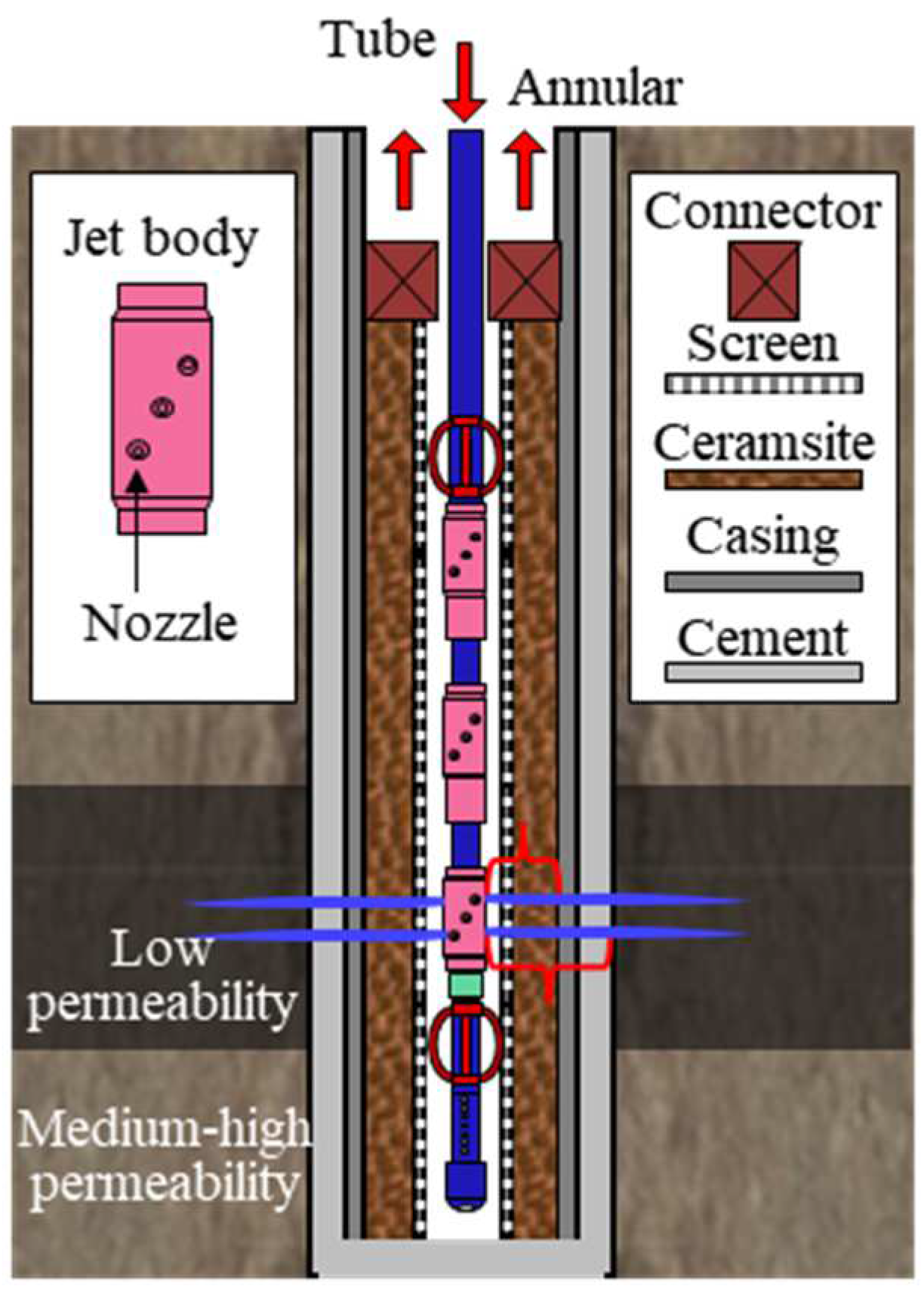
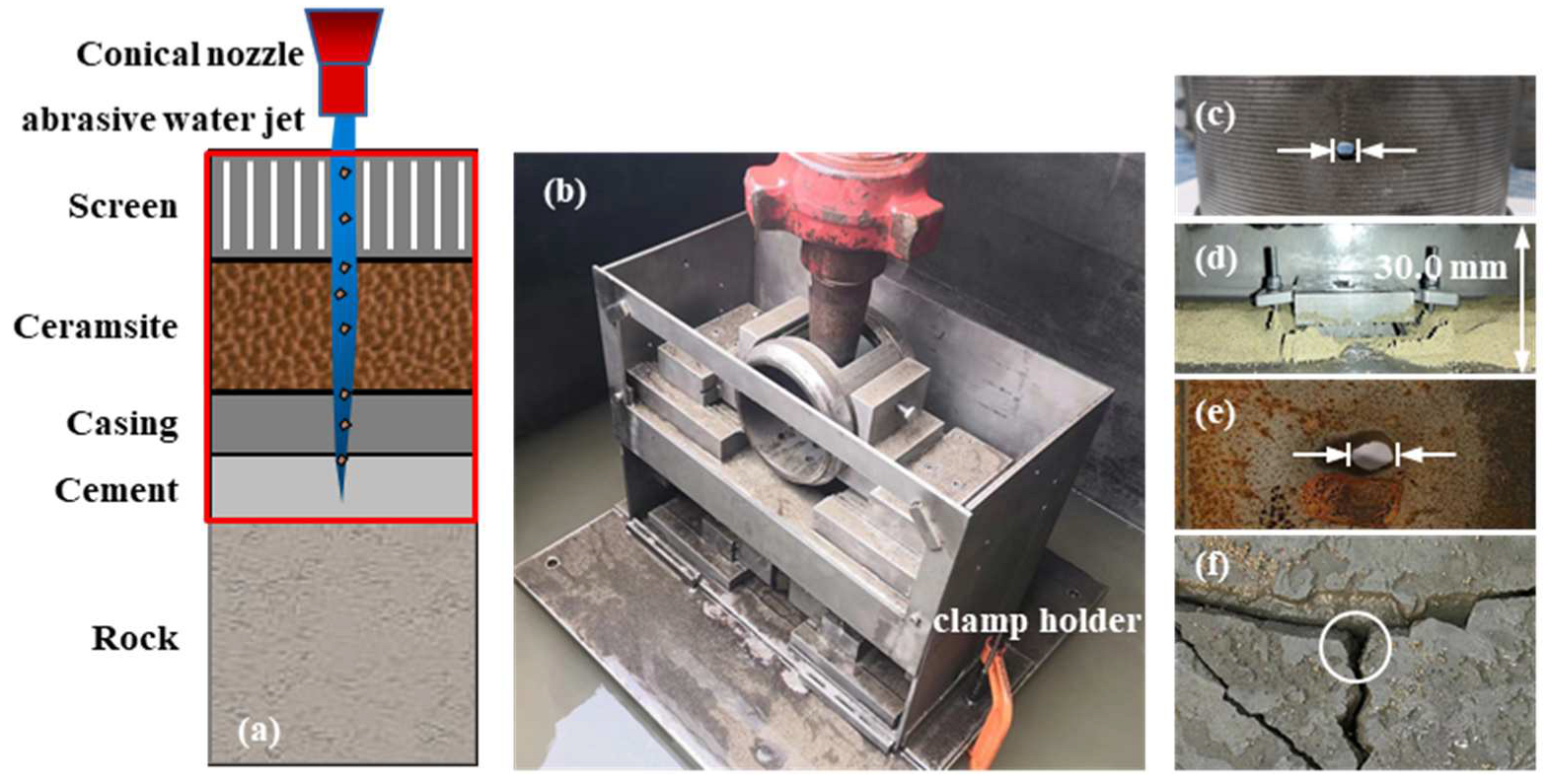
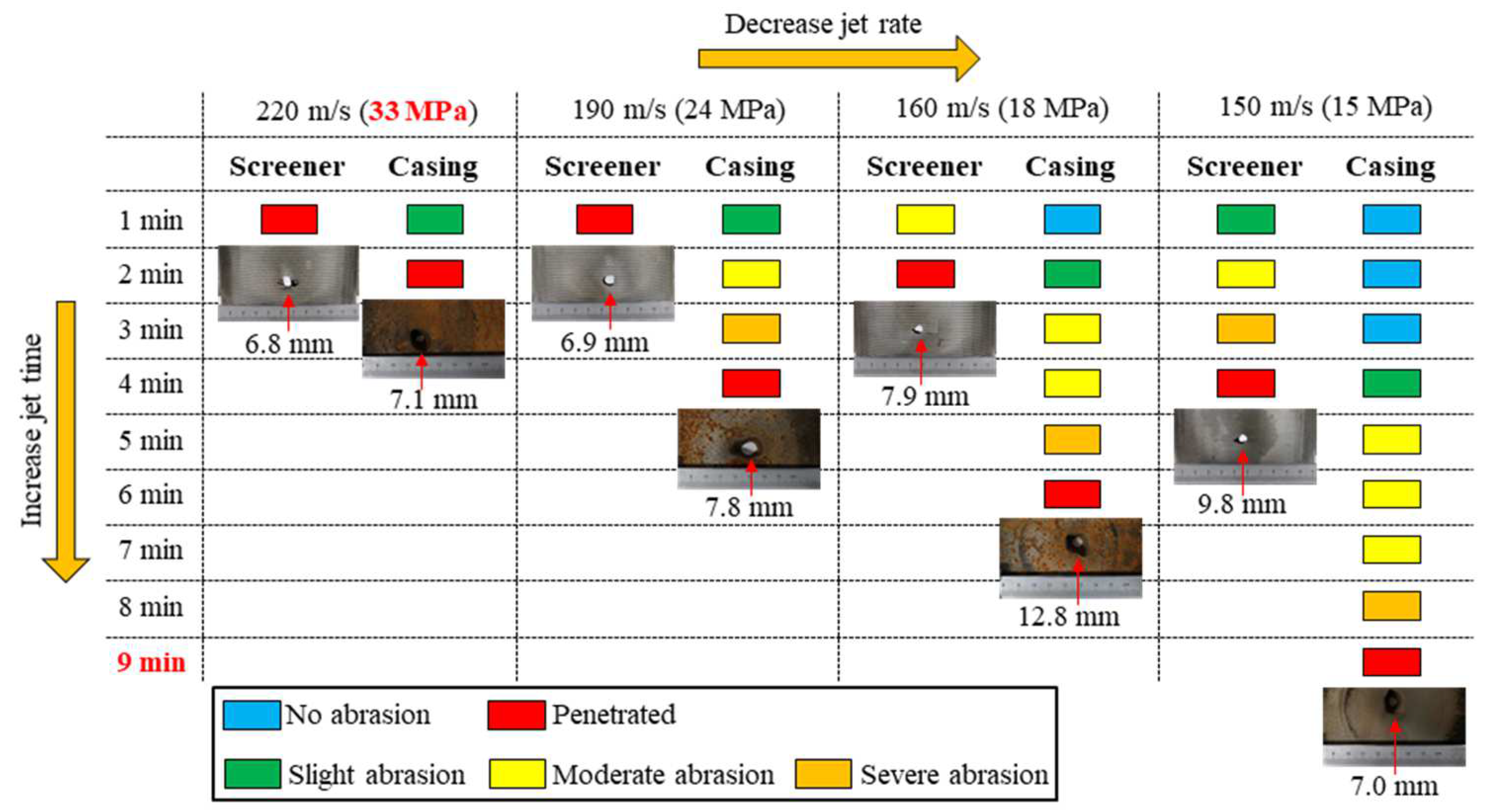
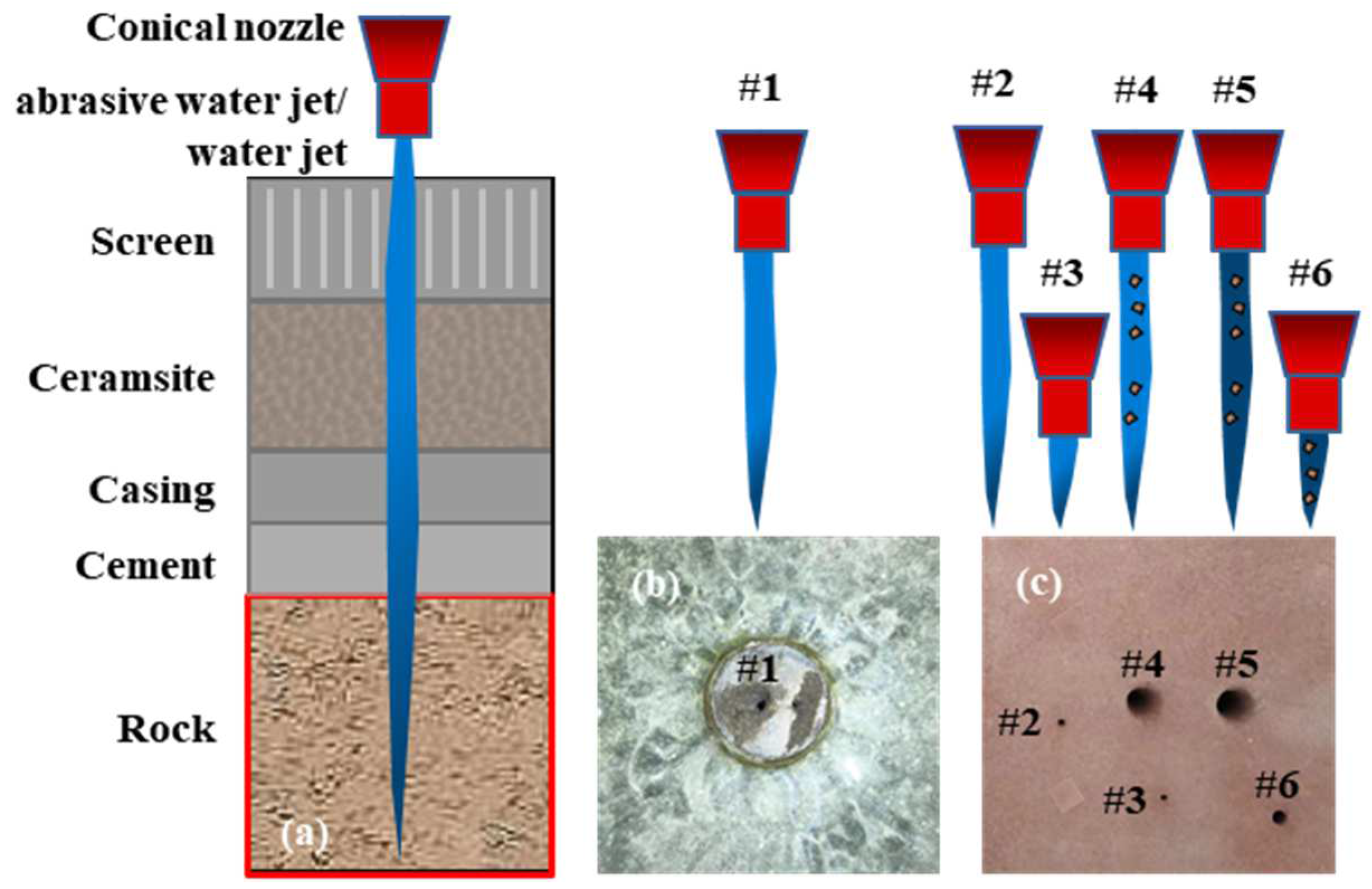
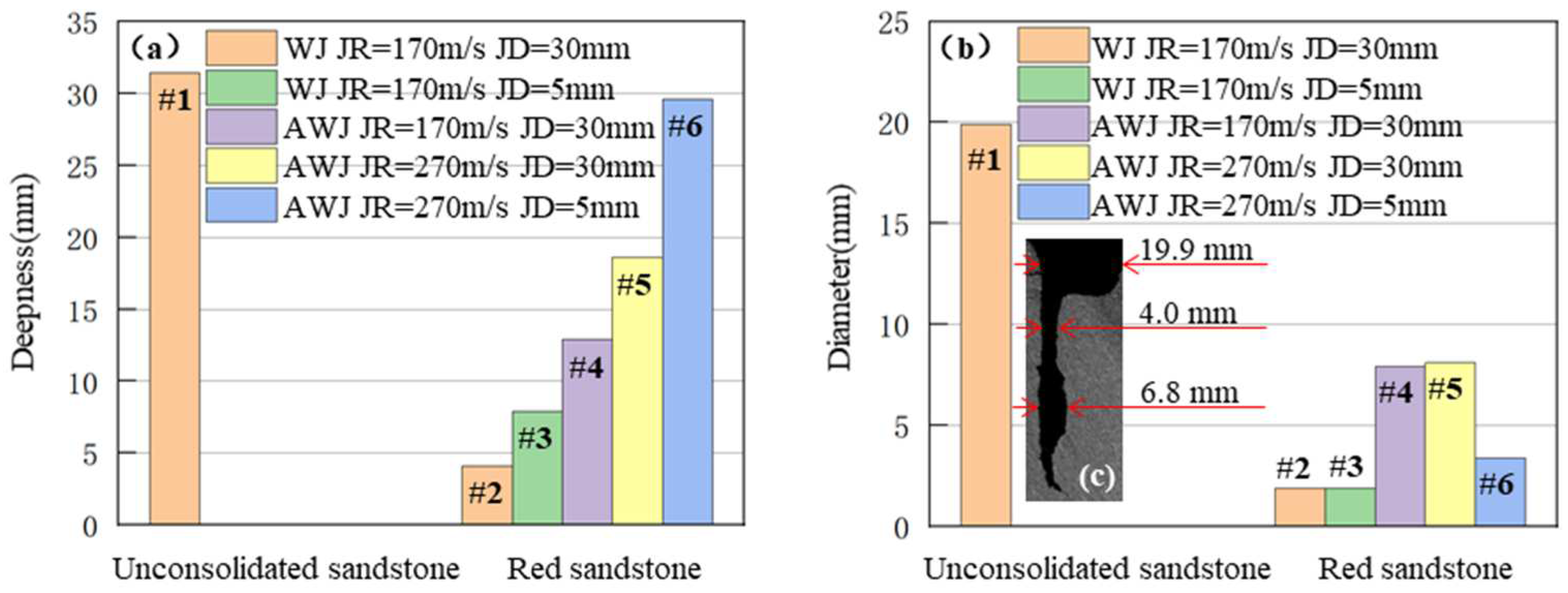
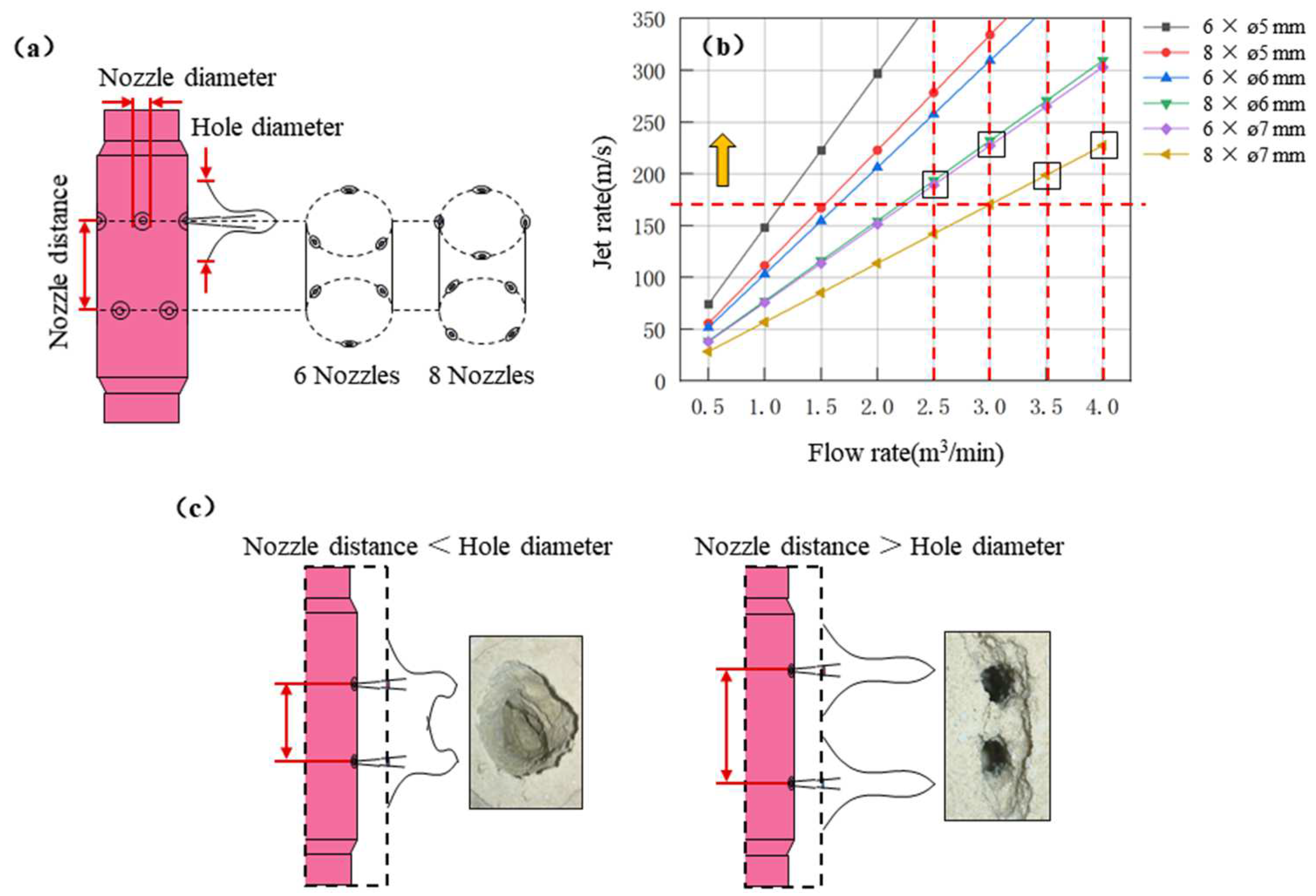

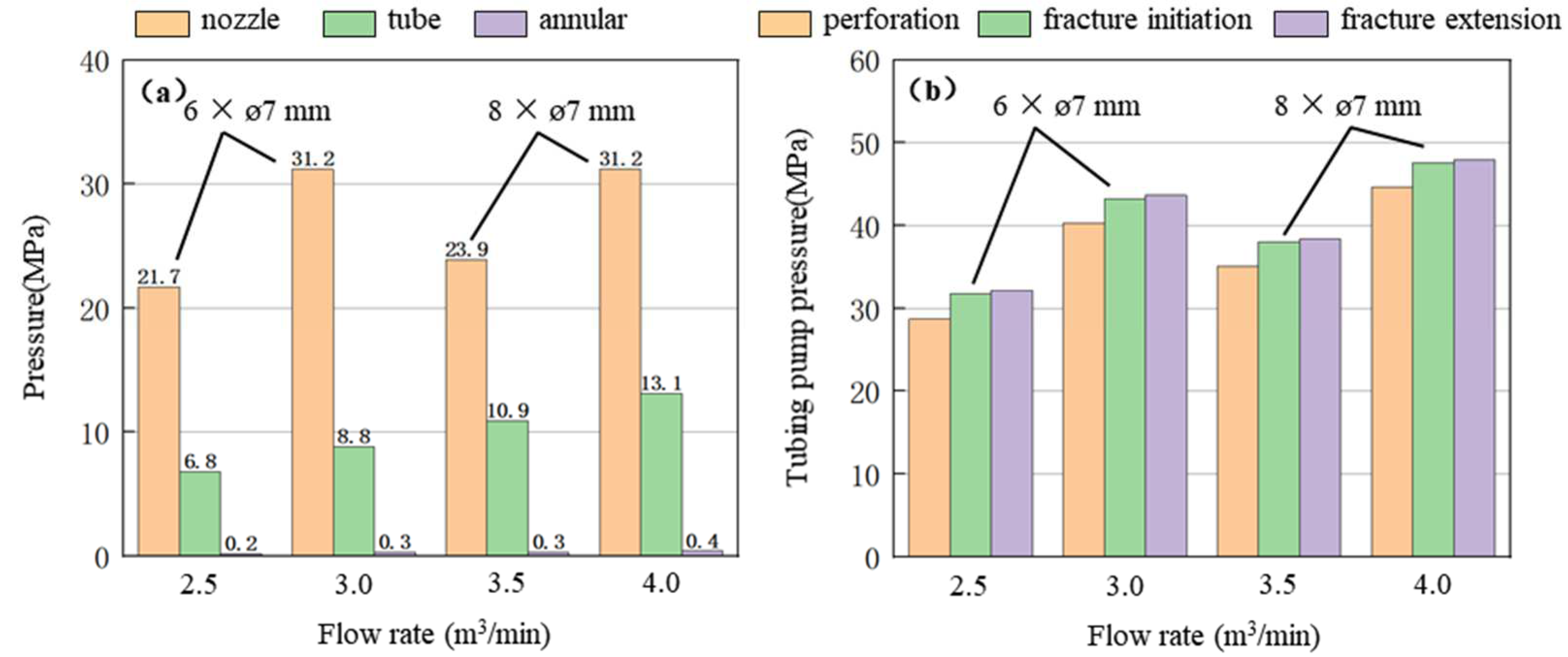
| Materials | Field Parameters | Experimental Parameters |
|---|---|---|
| Nozzle | conical, outlet diameter 5–7 mm | conical, outlet diameter 5 mm |
| Fluid | fracturing fluid | water |
| Abrasive | quartz sand, garnet, ceramisite, 20/40 mesh | ceramisite, 20/40 mesh, volume density of 1620 kg/m3, apparent density of 2950 kg/m3, compressive strength of 69 MPa |
| Sand concentration | 6–8% Volume ratio | 5% Volume ratio |
| Screener | 139.7 mm wire-wound screener, base pipe of 25.3 kg/m and N80 rank | 139.7 mm wire-wound screener nipple, base pipe of 25.3 kg/m and N80 rank, side window for nozzle |
| Gravel pack | ceramist, 20/40 mesh, thickness 37 mm | ceramist, 20/40 mesh, thickness 30 mm |
| Casing | 244.5 mm casing, 86.9 kg/m and N80 rank | 244.5 mm casing, 86.9 kg/m and N80 rank |
| Cement | Portland cement, Water-cement ratio 0.44, thickness 33 mm | Portland cement, Water-cement ratio 0.44, thickness 30 mm |
| Physical Parameters | Unconsolidated Sandstone | Red Sandstone |
|---|---|---|
| Density, kg/m3 | 1990 | 2230 |
| Porosity, % | 21.9 | 17.8 |
| Permeability, mD | 56.3 | 32.6 |
| Elasticity modulus, GPa | 0.29 | 8.71 |
| Poisson ratio | 0.34 | 0.38 |
| uniaxial compressive strength, MPa | 2.7 | 39.5 |
| Classification | Name | Parameter |
|---|---|---|
| Geology | Vertical depth, m | 2000 |
| Fracture initiation pressure gradient, MPa/m | 0.0185 | |
| Fracture extension gradient, MPa/m | 0.0150 | |
| Well | Oblique depth, m | 2500 |
| Inside diameter of casing, mm | 224.4 | |
| Tool | Nozzle combination | 6 × ø7 mm/8 × ø7 mm |
| Inside diameter of tubing, mm | 76 | |
| Outside diameter of tubing, mm | 88.9 | |
| Process | Pumping rate, m3/min | 2.5, 3.0 3.5, 4.0 |
| Fracturing fluid density, kg/m3 | 1050 | |
| Fracturing fluid viscosity, mPa·s | 1.12 | |
| Flow coefficient | 0.22 |
Disclaimer/Publisher’s Note: The statements, opinions and data contained in all publications are solely those of the individual author(s) and contributor(s) and not of MDPI and/or the editor(s). MDPI and/or the editor(s) disclaim responsibility for any injury to people or property resulting from any ideas, methods, instructions or products referred to in the content. |
© 2023 by the authors. Licensee MDPI, Basel, Switzerland. This article is an open access article distributed under the terms and conditions of the Creative Commons Attribution (CC BY) license (https://creativecommons.org/licenses/by/4.0/).
Share and Cite
Liu, Y.; Xu, P.; Zhang, L.; Zou, J.; Lan, X.; Sheng, M. Lab Experiments for Abrasive Waterjet Perforation and Fracturing in Offshore Unconsolidated Sandstones. Processes 2023, 11, 3137. https://doi.org/10.3390/pr11113137
Liu Y, Xu P, Zhang L, Zou J, Lan X, Sheng M. Lab Experiments for Abrasive Waterjet Perforation and Fracturing in Offshore Unconsolidated Sandstones. Processes. 2023; 11(11):3137. https://doi.org/10.3390/pr11113137
Chicago/Turabian StyleLiu, Yigang, Peng Xu, Liping Zhang, Jian Zou, Xitang Lan, and Mao Sheng. 2023. "Lab Experiments for Abrasive Waterjet Perforation and Fracturing in Offshore Unconsolidated Sandstones" Processes 11, no. 11: 3137. https://doi.org/10.3390/pr11113137
APA StyleLiu, Y., Xu, P., Zhang, L., Zou, J., Lan, X., & Sheng, M. (2023). Lab Experiments for Abrasive Waterjet Perforation and Fracturing in Offshore Unconsolidated Sandstones. Processes, 11(11), 3137. https://doi.org/10.3390/pr11113137











